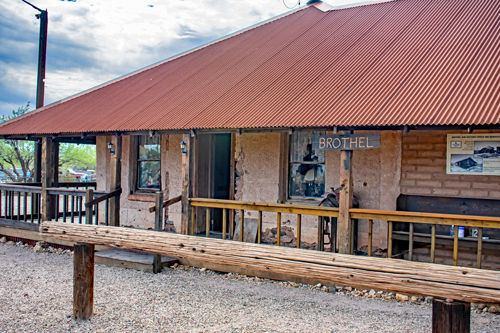Despite Three Closings, Vulture Mine Still Delivers Gold; Just in a Different Way
- Larry Nader, Larry Nader Photography & Art

- May 23, 2022
- 4 min read
Published May 23, 2022, for State 48 A2Z
Despite its quite ominous name, The Vulture Mine, and the subsequent Vulture City, have always been a producer of gold. The mine itself operated from 1866 until 1942 when it finally closed its operations for the final time. Founded in 1880, the town of Vulture City grew from the original mining camp and had its fair share of notorious incidents in its time.
It was in spring 1863 that Henry Wickenburg along with Isaac Van Bibber and Theodore Green were on their way back from following up on a report they had received of a gold strike in the Harquahala Mountains that turned out to be a bust. On the return trip, they found a prominent Quartz outcropping but continued to make their way back to camp along the Hassayampa River near present-day Wickenburg.
In November 1863 the trio placed a location notice at the site of the quartz outcropping but didn’t do anything more at the time. In fact, Wickenburg didn’t file a claim for the mine until May 1864 when he returned to the site, this time with four different men. At this time, they filed their claim for the Vulture Mine and Wickenburg himself assumed the position of President for the Vulture Mining District.
It wasn’t long before the mine was producing $700 a day worth of gold, but as operations expanded, the mine was faced with several major obstacles in its path of growth. Some of the hurdles faced included Indian raids, lack of mining operations knowledge, poor availability of good workers, and theft.
The solution to the water issue was eventually rectified by building an arrastra along the Hassayampa about 15-miles away and carting the ore to it for processing. A few years into the mine’s operation, Wickenburg, and the other mine claimants sold their shares of the mining company and their original footage to an east coast group. This group continued to grow operations and eventually, a 15-mile long, 6-inch pipeline was run from the river to bring water to the mining camp. With the water pipeline completed, the actual town of Vulture City started developing and grew to roughly 5,000 residents at its peak.
The mine however would see a couple of shutdowns before all operations ended in 1942. In its roughly nine decades of operation, the Vulture Mine produced 340,000 ounces of gold along with some 260,000 ounces of silver.
Over its 84-year existence, Vulture Mine ceased operations a total of three times, the last coming in 1942 when the US Government ordered the shutdown of all gold mining operations to reallocate resources for the war effort. The mine appealed the closing and was permitted to reopen but in a limited capacity. It only lasted another couple of years before shutting down for good and, with its closing, the town was abandoned. Today, some mining still happens here, but that site is separate from Vulture City and is not open to the public.
As for Vulture City, the current owners look to produce even more gold. This time in tourism as well as the paranormal. Mining camps were notoriously a rough place and Vulture City was no exception. Between men that lost their lives in the mine, those hung in camp for stealing ore, and the violence that comes when these men drank and gambled, there were a lot of violent deaths here. According to Vulture City legend, a total of 18 men were hung from the old ironwood tree that is still there outside Henry Wickenburg’s old cabin. This is possibly one of the main reasons why so many paranormalists, as well as history buffs, are drawn to Vulture City.
When visiting Vulture City, you will find over twelve restored buildings filled with time-appropriate artifacts from those early mining days to recreate the town. The site’s restored buildings include the Assay Office, Cookhouse, Brothel, Post Office, Henry Wickenburg’s Original Home, and the infamous Hanging Tree, among others.

You will want to give yourself at least 2-3 hours to walk the town and appreciate the work that has been done. It is also a great place to show your kids what life was like back in the late 1800s. You can choose a self-guided tour or take a 2-hour guided tour. Their hours and tour times may vary with the seasons, so be sure to check their website or call them before you head out. For more information on Vulture City, visit their web page here.
That'll wrap things up for this week. As always, thanks for reading, stay safe, and happy travels. Be sure to like and follow us on social media (links below), share our blog posts, and feel free to give us your feedback. And, if you go somewhere in Arizona that you think others should know about, please let us know so we can add it to our travel list. We’d love to hear from you. Peace!
All content is © 2022, Larry Nader & Larry Nader Photography & Art
State 48 A2Z Social Media Links
Larry Nader Photography & Art Social Media Links
Our Online Art Stores
Shop these sites to select our photography and digital art printed on your choice of wall art mediums, or on clothing, household items, office items, and more.



































































Comments